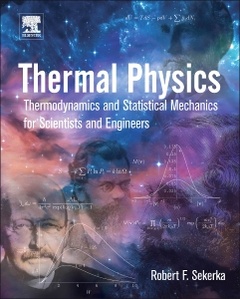Description
Thermal Physics
Thermodynamics and Statistical Mechanics for Scientists and Engineers
Author: Sekerka Robert Floyd
Language: English
Subjects for Thermal Physics:
137.79 €
In Print (Delivery period: 14 days).
Add to cartSupport: Print on demand
Description
/li>Contents
/li>Readership
/li>Biography
/li>Comment
/li>
In Thermal Physics: Thermodynamics and Statistical Mechanics for Scientists and Engineers, the fundamental laws of thermodynamics are stated precisely as postulates and subsequently connected to historical context and developed mathematically. These laws are applied systematically to topics such as phase equilibria, chemical reactions, external forces, fluid-fluid surfaces and interfaces, and anisotropic crystal-fluid interfaces.
Statistical mechanics is presented in the context of information theory to quantify entropy, followed by development of the most important ensembles: microcanonical, canonical, and grand canonical. A unified treatment of ideal classical, Fermi, and Bose gases is presented, including Bose condensation, degenerate Fermi gases, and classical gases with internal structure. Additional topics include paramagnetism, adsorption on dilute sites, point defects in crystals, thermal aspects of intrinsic and extrinsic semiconductors, density matrix formalism, the Ising model, and an introduction to Monte Carlo simulation.
Throughout the book, problems are posed and solved to illustrate specific results and problem-solving techniques.
Advanced undergraduate and graduate students in physics and chemical and engineering sciences; researchers in academia and industry working in these areas
- Includes applications of interest to physicists, physical chemists, and materials scientists, as well as materials, chemical, and mechanical engineers
- Suitable as a textbook for advanced undergraduates, graduate students, and practicing researchers
- Develops content systematically with increasing order of complexity
- Self-contained, including nine appendices to handle necessary background and technical details
These books may interest you

Essential Statistical Physics 40.64 €



